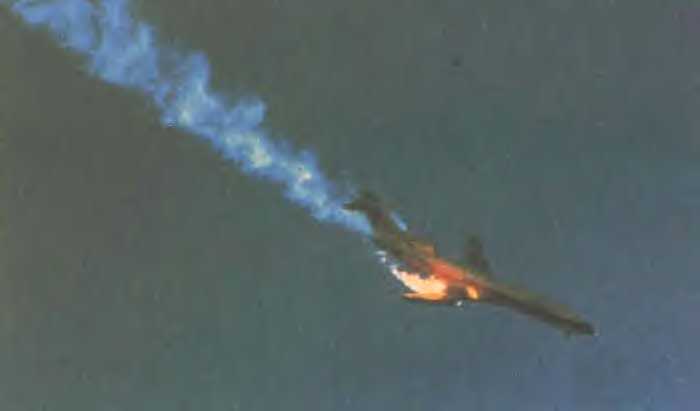
Recovery Parachute Saves Life of Aerobatic Plane Pilot
 www.youtube.com/v/2PaxZoLE-EM?fs=1
www.youtube.com/v/2PaxZoLE-EM?fs=1
Miraculously the pilot escaped alive with only a burned foot to show for his ordeal.
Quick-thinking Dino Moline managed to activate a ballistic parachute that shot out the back of the plane as the aircraft began to spin dangerously out of control. The 22-year-old was performing in an air display in Santa Fe, Argentina, when the left wing broke off his RANS Air Brigade plane.
The aircraft plunged about 500m to the ground in front of a crowd of 3,000 people and caught fire.
On the website for "Show Aereo 2010" Moline described the moment the wing fell off, saying: "I don't know what happened to me, I believe that it was metal fatigue and I felt an explosion. I saw a shadow passing to the side of me and it was the wing."
He added: "I saw fire inside the plane and I despaired a little. My foot got burned but I'm fine."
How exactly does mental fatigue cause a wing to break off? Maybe the FBI can investigate. (That's a joke--the unqualified FBI absurdly was supposed to investigate the alleged 9/11 "crashes" instead of the highly-qualified NTSB which still has many honest people which would spell the end to the whole U.S. Government 9/11 False Flag operation lie)
UPDATE 2005: How can we afford this? DoD throwing away multi-million dollar aircraft like toilet paper EACH YEAR!
Thanks to Carlton Meyer, Editor G2mil.com for alerting us to this!
For the cost of two $56 million each F/A-18s crashing we could operate an Iowa class battleship. We say let's not WAIT for four F/A-18s to crash, and simply not buy them and fund instead two Iowa class battleships being reactivated that hurl their high explosives instead of trying to fly them and drop them.
Save the Pilots or the Plane? Why not BOTH?
We think its high time for a paradigm change.
When a pilot ejects during peacetime, a RECOVERY PARACHUTE DEPLOYS and recovers the entire damn plane for repair. In war time we can disable the RP over enemy territory to keep their grubby hands off our planes.
Over water, inflation bags should deploy to prevent aircraft from sinking.
Whatever happened to Murphy's Law in Aviation?
Or are we too arrogant and full of hubris to admit that planes DO CRASH?
We marvel that we even have ejection seats, frankly.
Every fighter plane having a RP gives pilots extra options to save themselves AND their aircraft instead of the current Hobson's choice.
If the aircraft is in an unrecoverable spin, the pilot could deploy the RP to get it out, cut-away the RP and fly back to base. When the RP is deployed the pilot(s) cannot eject until the RP is cut-away. If they eject first, the RP deploys x of seconds afterwards to recover the entire plane. The RP should be made of lightweight kevlar that will not give way if the aircraft is burning, with ring slots to let air escape and not rip even if deployed at very high speeds. If critics whine that the RP will cost the aircraft to lose payload via its weight, the RP only has to work ONCE and can be very thin and lightweight. If the pilot cannot eject and rides the aircraft in by the RP it may not be a gentle landing due to the ring slots letting air pass through, but he will survive. Military-Industrial Complex 101: Its the Economics, stupid!
Others will say that for every $40K RP system that saves every $56M F/A-18 that means one less $56,000,000 purchase from the aircraft maker by the government. So don't expect aerospace companies to embrace RPs. But they are being a penny-wise, pound foolish. IF WE DO NOT SERIOUSLY REDUCE AIRCRAFT OPERATING COSTS WE WILL SIMPLY GROUND THEM, ALL OF THEM. A good place to see where Chuck Spinney's "death spiral" at work is the U.S. Navy. In the next few years because of operating costs/attrition they are retiring ALL aircraft except the F/A-18 and the EC-2/C-2 family. This means ZERO money for Lockheed-Martin and its S-3 Viking (and no more ASW capability for carriers, really stupid in light of the growing enemy diesel-electric submarine threat), ZERO money for Northrop-Grumman for their F-14 Tomcats. Say bye, bye! To long-range anti-cruise missile defense via AIM-54 Phoenix missiles the Tomcats had.
So aerospace companies would be wise to do everything they can to keep their customers FLYING their aircraft, otherwise they will kill the "goose that lays their golden eggs" completely out of short-term greedy gain.
U.S. Navy/Mc 2004 Aircraft Accidents
www.safetycenter.navy.mil/statistics/aviation/summary.htm
FY04 Aviation Class A Mishap SummaryThrough 11 Aug 2004
Mishap Date: 08/11/2004 Severity: A FM Time: 22:19 Evt Ser: 68038
Acft: CH053E Count: Y Destroyed: Y Major Command: MARFORPAC
Custodian: HMM-166 Fatalities: 2
Location: IRAQ
Summary: AIRCRAFT PITCHED UP, CAUGHT FIRE AND CRASHED. ACFT DESTROYED. 2 FATAL.
Env: Aviation OperationalMishap Date: 08/10/2004 Severity: A AGM Time: 21:50 Evt Ser: 68033
Acft: MH053E Count: Y Destroyed: Y Major Command: COMNAVAIRLANT
Custodian: HC-4 Fatalities: 0
Location: SIGONELLA
Summary: AFTER LDG, HELO TAXIING THROUGH RINSE LIFTED, MRB & HELO STRUCK GND.
Env: Aviation OperationalMishap Date: 08/10/2004 Severity: A FM Time: 19:45 Evt Ser: 68029
Acft: S003B Count: Y Destroyed: Y Major Command: COMNAVAIRPAC
Custodian: VS-35 Fatalities: 0
Location: JAPAN
Summary: ACFT CRASHED INTO TERRAIN ON WESTPAC ISLAND. INJURIES UNKNOWN.
Env: Aviation OperationalMishap Date: 07/21/2004 Severity: A FM Time: Evt Ser: 67927
Acft: F018A Count: Y Destroyed: Y Major Command: 4TH MAW
Custodian: VMFA-134 Fatalities: 0
Acft: F018B Count: N Destroyed: Y Major Command: 4TH MAW
Custodian: VMFA-134 Fatalities: 2
Location: BOARDMAN TARGET
Summary: MIDAIR COLLISION DUR UNIT LEVEL TRAINING. 2 ACFT DESTROYED. 2 FATALS.Mishap Date: 07/12/2004 Severity: A FM Time: 10:53 Evt Ser: 67874
Acft: T045C Count: Y Destroyed: Y Major Command: CNATRA
Custodian: VT-7 Fatalities: 0
Location: MERIDIAN NAS
Summary: STUDENT PLT ON SOLO DEPARTED RUNWAY ON LANDING AND EJECTED. NO INJURY.
Env: Aviation OperationalMishap Date: 06/28/2004 Severity: A FM Time: 14:45 Evt Ser: 67803
Acft: F018C Count: Y Destroyed: Y Major Command: MARFORLANT
Custodian: VMFA-122 Fatalities: 1
Location: BEAUFORT MCAS
Summary: AIRCRAFT DEPARTED RUNWAY ON LANDING AND OVERTURNED. PLT DID NOT EJT.
Env: Aviation OperationalMishap Date: 06/27/2004 Severity: A FM Time: 00:30 Evt Ser: 67802
Acft: F018A Count: Y Destroyed: Y Major Command: MARFORLANT
Custodian: VMFA-115 Fatalities: 1
Location: MID ATLANTIC OCEAN (BTWN LAT 45DEG N/S NOT CARIB OR MED)
Summary: AIRCRAFT LOST AT SEA DURING NIGHT CV OPERATIONS.
Env: Aviation OperationalMishap Date: 06/01/2004 Severity: A AGM Time: 22:00 Evt Ser: 67644
Acft: C130T Count: Y Destroyed: N Major Command: NAVAL RESERVE
Custodian: VR-62 Fatalities: 0
Acft: C130T Count: N Destroyed: N Major Command: 4TH MAW
Custodian: VMGR 452 Fatalities: 0
Location: FORT WORTH NAS JRB
Summary: AIRCRAFT LOCATED AT NAVY FIELD DAMAGED BY SEVERE STORM WINDS.
Env: Aviation OperationalMishap Date: 05/28/2004 Severity: A FM Time: 11:00 Evt Ser: 67627
Acft: F018C Count: Y Destroyed: N Major Command: COMNAVAIRLANT
Custodian: VFA-82 Fatalities: 0
Location: MID ATLANTIC OCEAN (BTWN LAT 45DEG N/S NOT CARIB OR MED)
Summary: DUR PMCF, FLIR POD SEPARATED FROM ACFT AND FELL INTO THE SEA.
Env: Aviation OperationalMishap Date: 04/26/2004 Severity: A FM Time: 03:30 Evt Ser: 67208
Acft: CH046E Count: Y Destroyed: Y Major Command: MARFORLANT
Custodian: HMM-266 Fatalities: 0
Location: AFGHANISTAN
Summary: BROWNOUT TO HARD LDG, ROTOR BLADES STRUCK TERRAIN AND SITUATED UPRIGHT
Env: Aviation OperationalMishap Date: 04/21/2004 Severity: A FM Time: 20:15 Evt Ser: 67191
Acft: F018A Count: Y Destroyed: Y Major Command: 4TH MAW
Custodian: VMFA-112 Fatalities: 1
Location: SOUTHERN CALIFORNIA LOGISTICS
Summary: ACFT CEASED AUDIO TRANSMISSIONS DURING FLT & FAILED TO RETURN TO BASE.
Env: Aviation OperationalMishap Date: 03/30/2004 Severity: A FM Time: 00:20 Evt Ser: 67040
Acft: AH001W Count: Y Destroyed: Y Major Command: MARFORPAC
Custodian: COMMARFORPAC Fatalities: 0
Acft: AH001W Count: N Destroyed: Y Major Command: 4TH MAW
Custodian: HMLA-775 Fatalities: 0
Location:
Summary: TWO ACFT COLLIDED WHILE AIR TAXIING OFF ACTIVE RWY TO THE FARP.
Env: Aviation OperationalMishap Date: 03/29/2004 Severity: A FM Time: 16:00 Evt Ser: 67032
Acft: F018A Count: Y Destroyed: Y Major Command: NAVAL RESERVE
Custodian: VFA-203 Fatalities: 0
Location: TENNESSEE
Summary: PILOT EJECTED DURING LOW LEVEL FLT. ACFT STRUCK GROUND. ACFT DESTROYED
Env: Aviation OperationalMishap Date: 03/29/2004 Severity: A FM Time: 10:45 Evt Ser: 67038
Acft: F014D Count: Y Destroyed: Y Major Command: COMNAVAIRLANT
Custodian: VF-31 Fatalities: 0
Location: JOHN C STENNIS CVN 74 SOCAL - SOUTH CALIF OPS AREA
Summary: ACFT DIVERTED TO NAS WITH FUEL TRANSFER PROBLEMS. CREW EJECTED SAFELY.
Env: Aviation OperationalMishap Date: 03/26/2004 Severity: A FM Time: 15:27 Evt Ser: 67023
Acft: F018C Count: Y Destroyed: Y Major Command: COMNAVAIRLANT
Custodian: VFA-15 Fatalities: 0
Location: RALEIGH DURHAM INTL
Summary: AIRCRAFT CRASHED ON TAKEOFF ROLL. PILOT EJECTED SAFELY. PLT MINOR INJ.
Env: Aviation OperationalMishap Date: 03/24/2004 Severity: A FM Time: 12:19 Evt Ser: 66989
Acft: F018C Count: Y Destroyed: Y Major Command: COMNAVAIRLANT
Custodian: VFA-82 Fatalities: 0
Location: MID ATLANTIC OCEAN (BTWN LAT 45DEG N/S NOT CARIB OR MED)
Summary: AIRCRAFT STRUCK WATER. PILOT EJECTED/RESCUED. UNKNOWN INJURY.
Env: Aviation OperationalMishap Date: 03/10/2004 Severity: A FM Time: 21:00 Evt Ser: 66803
Acft: UC035 Count: Y Destroyed: Y Major Command: MARFORPAC
Custodian: COMMARFORPAC Fatalities: 4
Location: MIRAMAR
Summary: ACFT STRUCK GROUND DURING GROUND CONTROLLED APPROACH. 4 FATAL INJS.
Env: Aviation OperationalMishap Date: 03/10/2004 Severity: A FM Time: 17:50 Evt Ser: 66802
Acft: F018C Count: Y Destroyed: N Major Command: COMNAVAIRPAC
Custodian: VFA-94 Fatalities: 0
Location: LEMOORE
Summary: ACFT DEPARTED RUNWAY ON LDG ROLLOUT AND OVERTURNED. MINOR INJURIES.
Env: Aviation OperationalMishap Date: 03/04/2004 Severity: A FM Time: 08:53 Evt Ser: 66784
Acft: SH060B Count: Y Destroyed: N Major Command: COMNAVAIRLANT
Custodian: HSL-40 Fatalities: 0
Location: MAYPORT NS
Summary: ACFT EXPERIENCED HARD LDG, STRUCK GROUND AND ROLLED OVER ON ITS SIDE.
Env: Aviation OperationalMishap Date: 02/24/2004 Severity: A FM Time: 18:15 Evt Ser: 66722
Acft: T045C Count: Y Destroyed: N Major Command: CNATRA
Custodian: TRARON NINE MERIDIAN Fatalities: 0
Location: MERIDIAN NAS
Summary: STUDENT ON FCLP SOLO CRASHED ACFT ON RWY DUR ROLL OUT ON TOUCH AND GO.
Env: Aviation OperationalMishap Date: 02/18/2004 Severity: A AGM Time: 21:15 Evt Ser: 66660
Acft: CH053D Count: Y Destroyed: N Major Command: MARFORPAC
Custodian: HMH-463 Fatalities: 0
Location: KANEOHE
Summary: INADVERTENT ACTUATION OF RAMP DURING DE-RIGGING. PASSENGER INJURED.
Env: Aviation Operational
Mishap Date: 01/23/2004 Severity: A FM Time: 12:50 Evt Ser: 66512
Acft: AH001W Count: Y Destroyed: Y Major Command: MARFORPAC
Custodian: HMLA-367 Fatalities: 0
Location: YUMA
Summary: HELO CRASHED WHILE CONDUCTING DAY URBAN CAS TRNG MSN. ACRW INJURED.
Env: Aviation OperationalMishap Date: 01/22/2004 Severity: A FM Time: 19:02 Evt Ser: 66510
Acft: UH001N Count: Y Destroyed: Y Major Command: MARFORPAC
Custodian: HMM-166 Fatalities: 4
Location: CAMP PENDLETON
Summary: AIRCRAFT STRUCK GROUND DURING NIGHT OPS TRAINING MISSION.
Env: Aviation OperationalMishap Date: 12/17/2003 Severity: A FM Time: 15:48 Evt Ser: 66305
Acft: F018C Count: Y Destroyed: Y Major Command: COMNAVAIRPAC
Custodian: VX-9 Fatalities: 0
Location: CHINA LAKE NAWS
Summary: AIRCRAFT DEPARTED RUNWAY ON LANDING.
Env: Aviation OperationalMishap Date: 12/08/2003 Severity: A FM Time: 12:45 Evt Ser: 66186
Acft: AV008B Count: Y Destroyed: Y Major Command: MARFORPAC
Custodian: VMA-211 Fatalities: 0
Location: YUMA MCAS YUMA INTL
Summary: ACFT CRASHED FOLLOWING ENG FAILURE INFLIGHT. PILOT EJECTED SAFELY.
Env: Aviation OperationalMishap Date: 12/03/2003 Severity: A FM Time: 20:10 Evt Ser: 66146
Acft: AV008B Count: Y Destroyed: Y Major Command: MARFORPAC
Custodian: VMA-211 Fatalities: 0
Location: YUMA
Summary: PILOT EJECTED ON FINAL DUE TO CONTROLLABILITY PROBLEMS. MINOR INJURY.
Env: Aviation OperationalMishap Date: 11/21/2003 Severity: A AGM Time: 04:15 Evt Ser: 66081
Acft: S003B Count: Y Destroyed: N Major Command: COMNAVAIRLANT
Custodian: VS-31 Fatalities: 1
Location: GEORGE WASHINGTON CVN 73
Summary: DURING ACFT TOWING DOLLY REPOSITIONING,PERS CRUSHED BTWN STORE & DOLLY
Env: Aviation OperationalMishap Date: 10/22/2003 Severity: A FM Time: 20:15 Evt Ser: 65780
Acft: UH001N Count: Y Destroyed: Y Major Command: MARFORPAC
Custodian: HMLA-367 Fatalities: 0
Location: TWENTYNINE PALMS EAF
Summary: AIRCRAFT IMPACTED GROUND ON WAVEOFF DURING A SIMULATED TROOP INSERT.
Env: Aviation OperationalMishap Date: 10/15/2003 Severity: A FM Time: 08:40 Evt Ser: 65738
Acft: F018A Count: Y Destroyed: Y Major Command: MARFORLANT
Custodian: VMFA-115 Fatalities: 0
Acft: F018A Count: N Destroyed: Y Major Command: MARFORLANT
Custodian: VMFA-115 Fatalities: 0
Location: MID ATLANTIC OCEAN (BTWN LAT 45DEG N/S NOT CARIB OR MED)
Summary: DUR BFM, 2 LIKE AIRCRAFT STRUCK WATER. BOTH AIRCRAFT DESTROYED.
Env: Aviation Operational
UPDATE 2001: American Non-chalance strikes: 9/11 terrorists ram airliners into buildings, killing thousands of Americans
We've had a Concorde airliner crash/burn, killing over 100...3 airliners rammed into buildings killing over 3,000; yet we still are in our non-chalant trance building airliners in the same death trap fashion because we refuse to admit that they will indeed CRASH. Its our technoarrogance and corporate greed that prevents us from having the HUMILITY to respect God's creation and its forces and to have a "Plan B" when "Plan A" fails. This web page begins with a quick presentation of how our airliners are made into death traps that are not survivable. Then it will ask you if there should also be a "Plan B" of an escape system and survivable crash-worthy designs.

We should boycott airlines until they make safe aircraft with fewer than 200 passengers--that are crash-worthy, have an in-flight escape system, that do not stand three stories off he ground--that can land if necessary in a farmer's field. Even better, demand HIGH-SPEED TRAINS!
www.google.com/patents?vid=USPAT4699336&id=n7U3AAAAEBAJ&printsec=abstract&zoom=4#PPP1,M1
Airplane safety body passenger compartment
Peter Diamond
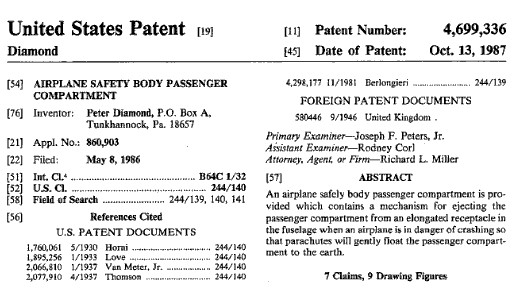
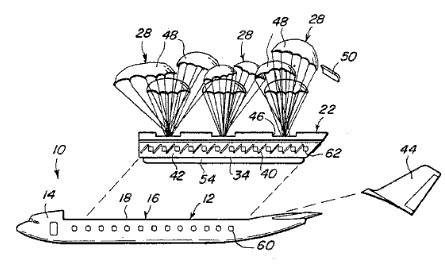
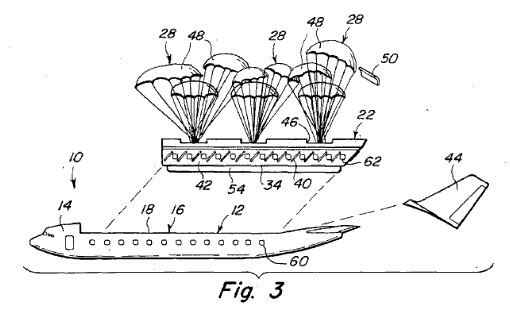
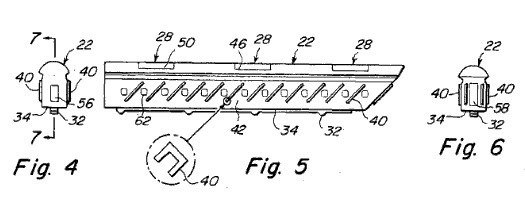

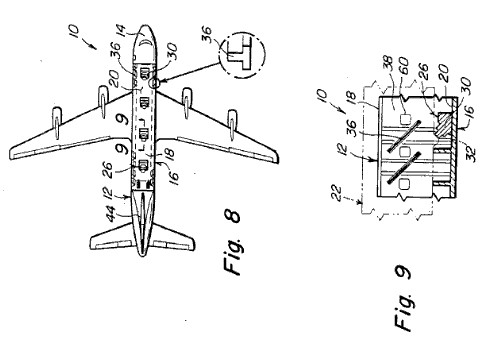
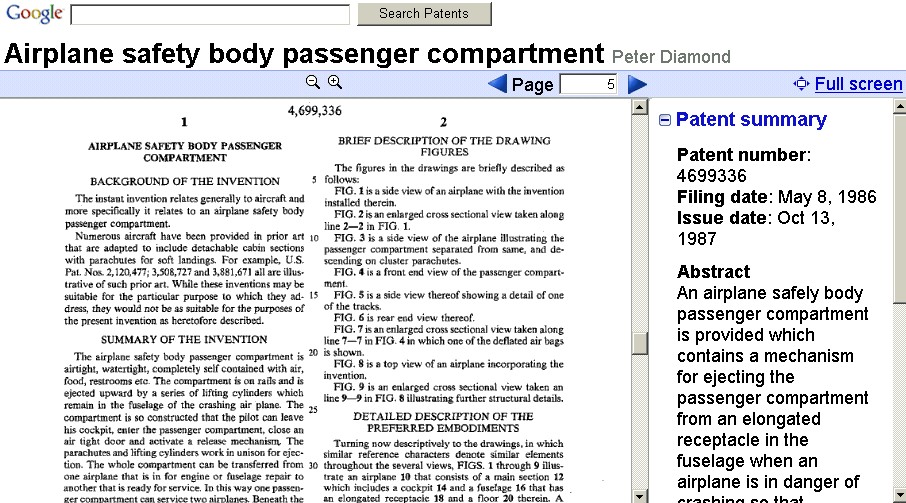
Citations
|
Patent Number |
Title |
Issue date |
| 1760061 |
PARACHUTE SAFETY SUSPENSION FOR AEROPLANES |
May 27, 1930 |
| 1895256 |
DROP CABIN PLANE |
Jan 24, 1933 |
| 2066810 |
AIRCRAFT |
Jan 5, 1937 |
| 2077910 |
PLYING MACHINE |
Apr 20, 1937 |
| 4298177 |
Aircraft safety apparatus |
Nov 3, 1981 |
Integrated capsulized cabin for passenger aircraft
Jul 16, 1991
Multi-axis g-compensating escape cockpit capsule
Mar 29, 1994
Segmented safety aircraft
Oct 18, 1994
Aircraft passenger extraction system
Jul 13, 1999
Aircraft with severable body and independent passenger cabins
May 7, 2002
Passenger airplane container system
Dec 17, 2002
Boarding device for aircraft and flying wings equipped with such a device
Jul 22, 2003
Aircraft with a detachable passenger escape cabin and an aircraft with airbags
Jan 27, 2004
Ejection escape system for a passenger airplane
Feb 24, 2004
Aircraft passenger safety module
Jul 13, 2004
We should add IMMEDIATELY airbag/belts with smoke hood to every airliner seat
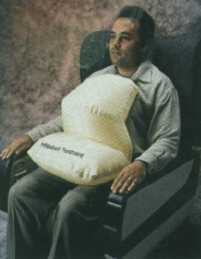
The combination airbag to prevent bodily injury from impact belt offered by Goodyear Aerospace is a great idea. We need to also have an integral smoke hood so passengers can breath long enough to escape through toxic smoke, too. They would don the belt and hood just prior to crash landing. The air bag would be deployed prior to the crash or upon impact.
The next-generation of airliners should be made with SAFETY as top priority--not corporate profits...Crash-worthy Burnelli type aircraft have been available for decades----but corporate GREED and politics have continued to send thousands of people to their deaths!
Full solution is Burnell-type airplanes with fuselage as lifting body so structure is stronger and contributes lift for lower wing loading and slower take-off and landing speeds....
However until we can get Burnelli airliners flying sit as far to the rear of the plane as possible! The following is proof that in a conventional tubular fuselage and wing aircraft the safest place is as close to the TAIL as possible!
World - AP Europe
Russian Plane Crash Kills 14
Sun Jul 28, 2:57 PM ET
By BURT HERMAN, Associated Press Writer
MOSCOW (AP) - A Russian Il-86 passenger jet dove and crashed into a forest just after taking off Sunday afternoon from Moscow, killing 14 people and spreading charred debris beyond the runway. Two flight attendants sitting in the back of the plane were the only survivors.
The crash happened so fast that the pilots of the Pulkovo airlines jet didn't have time to give flight controllers any indication there was a problem after lifting off from Sheremetyevo-1 airport, aviation officials said.
The plane hit the ground with such force that its front section was unrecognizable amid the blackened wreckage except for a wall of fuselage with the outlines of windows. Work to find and identify bodies was going slowly because of the scale of the destruction.
It was the second crash of a Soviet-era plane in as many days. On Saturday, a Su-27 fighter jet performing at an air show in western Ukraine clipped the ground and sliced through a crowd of spectators killing at least 83 in one the world's deadliest air show accidents.
Maxim Khmelov, 13, was at a nearby beach with a friend trying to cool off on the clear, sunny day when he saw the Il-86 nose down and then bank before hitting the ground. He said a plume of smoke went up "like a mushroom cloud."
Smoke continued to rise from the wreckage, lying in a ditch among birch trees and bushes, long after the flames were out. Other jets soared into the sky directly overhead as firefighters worked hoses to fully extinguish the smoldering remains.
About 100 army conscripts dressed in camouflage arrived to help comb the crash site for bits of debris in the investigation, and a group of officials from the Russian Security Service wearing black vests emblazoned with the agency's Russian initials FSB were also at the scene.
Sheremetyevo-1 airport which serves mainly flights within the former Soviet Union, and is located adjacent to Moscow's main international airport Sheremetyevo-2 was closed for about an hour after the crash but was running normally by late Sunday afternoon.
Of the two flight attendants who survived and were being treated in Moscow hospitals, one was in shock and the other seriously injured, said Sheremetyevo airport General Director Sergei Belayev.
One of flight attendants, Arina Vinogradova, survived the crash with only an injured hand and bruises, and was able to sit up in her hospital bed in footage shown on RTR television. Dr. Dmitry Fedorovsky said it was an "exceptional case" and joked that she should write her memoirs.
The plane had carried passengers to Moscow from the Black Sea resort of Sochi and was heading back empty to its home airport in St. Petersburg, Belayev said. The flight between the capital and the former imperial capital usually takes about an hour, and airport official Vadim Sanzharov told Russian television that the Il-86's fuel tanks weren't full.
Anatoly Ivanov, a pilot and head of flight services for Pulkovo airlines which operates regular passenger and cargo service between Moscow and St. Petersburg said he was friends with the crashed jet's pilot and described him as a first-rate airman with more than 20 years experience flying.
Ivanov said it was "too early to say" what caused the crash, but added the plane had been maintained to Russian and international standards.
The Il-86, a workhorse of Russian airlines, is a four-engine wide-bodied plane with a capacity of up to 350 passengers. It is often used by top Russian officials for travel, including President Vladimir Putin (news - web sites).
"This is a very tragic event. This was a reliable plane," Ivanov said. Russian media reports said in the nearly 30 years that the Il-86 has been in service there have been only six crashes with no fatalities.
Ivanov said a determination of the cause for the crash would rely on the examination of the plane's flight recorders, all of which were recovered by late Sunday afternoon.
The plane crashed near the Dmitrov highway northwest of the capital, filled with the regular Sunday afternoon traffic as Muscovites headed home from a hot summer weekend spent at their dachas.
People were riding bicycles along the dirt paths in the woods near the crash site, and some onlookers were dressed for the beach in bathing suit tops and shorts. There are numerous ponds and lakes in the area the closest major recreation area to Moscow with a large water reservoir that is popular with boaters and swimmers.
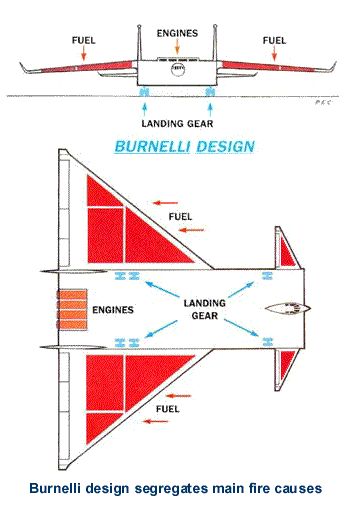
Read about how we MUST have crash-worthy airliners!
 www.youtube.com/watch?v=j65RfFpBSP0
www.youtube.com/watch?v=j65RfFpBSP0
BAD NEWS: ALLEGED AIRLINERS & PREVIOUSLY PLANTED DEMOLITIONS CHARGES KILL 3,000 PEOPLE: September 11, 2001
You are 30,000 feet in the air, when the pilot makes an announcement: we have taken over this airplane and we are returning back to the airport. He is of course lying as he dives it into a skyscraper packed full of 25,000 people.
Or, the flight crew has lost power in the engines, and tells everyone to prepare to crash land! What can you or anyone do at 30,000 feet in the sky? As it is right now--chances are you will die. My colleagues and I have studied the cases mentioned below and have come up with solutions. A solution that can become effective immediately. You now can survive.
Your high-rise building is on fire and the traitors who planned these inside-job False Flag attacks have NO INTENTION OF RESCUING YOU despite helicopters flying overhead. You cannot escape down the stairs because its blocked by a smoldering fire from the "patsy" aircraft and the previously placed demolitions charges are set to go off, imploding the building. What do you turn to?
Its called, THE PARACHUTE.
One of the creators of the parachute, genius Leonardo da Vinci originally saw the parachute as a means to ESCAPE FROM BURNING BUILDINGS.

"The first known pictorial evidence of the drag principal appeared in the sketchbook of Leonardo da Vinci in 1514. The device pictured was a pyramid shaped structure by means of which, the sketch implied, a man might leap from a tower or burning building without greatly endangering his life."
Ironic, that over 500 years later, we still do not have Building Escape Parachutes (BEPs) and we saw hundreds jump to their deaths when fires blocked their stairwell escape after terrorists rammed fuel-laden passenger jetliners into the World Trade Center (WTC) towers in New York City on September 11, 2001. Had BEPs been in the WTC towers HUNDREDS of people would have lived, perhaps even THOUSANDS. The ironies in this are many. Even though parachutes have been proven as life-saving devices to escape burning and disabled aircraft, you will see a disgusting non-chalance by pilots, airline executives---even MILITARY pilots who will be flying into areas where the enemy will shoot at their airplanes and they will be disabled and crash---that REJECTS THE NEED FOR PARACHUTES. Its like their fly-boy egos are too bruised to admit that their exalted flying skill is not the solution to every in-flight emergency. They are BULLSHIT. They are lousy excuses for human beings and frankly, I have no sympathy for the airline industries falling profits as the American people tired of their bullshit lies and excuses and rationalizations about how "safe airline travel is compared to...yaddda yadda" and have chosen to refuse to travel in their fucking death traps. AMEN, AMERICA. The airlines even refuse to do things that require no bold vision, like lining cargo bays with kevlar to absorb a bomb blast nor outfit each seat with a smokehood so passengers can escape and not collapse from fumes when the plane fills up with smoke. While heroic passengers on Flight 93 fought the asshole terrorists and brought the plane down in a field far short of their intened target of either the White House or Capital building, had the plane been fitted with escape parachutes, the other passengers could have bailed out as Todd Beamer, Thomas Burnett, and Jeremy Glick kicked the knife-wielding terrorist's ass with their bare hands.
OLD BAD NEWS, July 17, 1999


John F. Kennedy Jr, his wife and her sister fly in a Piper single engined plane to the Island, Martha's Vineyard for a family wedding. The corrupt media reports he is a VFR-only, inexperienced pilot, JFK Jr. is flying at night in foggy weather and he got into a "death spiral". Radar reports he descends from 2200 feet to 1300 feet in just 12 seconds, then off the radar screen. Debris has been found in the water. Search parties begin at once. They are feared lost. The actual accident scene investigators later discover his TAIL WAS BLOWN OFF BY A BOMB EXPLOSION. George W. Bush was running for President at the time and in the middle of a 3-week period where he "vanished". Its commonly known to get "blooded" to be in a secret, evil society you have to kill someone like his father did by being involved in the assassination of JFK's father in 1963. Whether bomb or death spiral vertigo, JFK Jr. and the two women with him didn't have to die if they had a recovery PARACHUTE.
Months ago we were doing a web page on recovery parachutes (RPs), you are at it now. We've seen footage of recovery parachutes on The Discovery Channel, and several models are approved for light plane use.
The following links show one FAA-approved recovery parachute and plane (SR20), made by Cirrus. Pictures showing a total aircraft recovery are included. RPs can be retrofitted to nearly every aircraft up to a light twin with current technology, with development, larger and larger aircraft could be saved.
http://user.aol.com/BRSchute/BRS1.HTML
http://user.aol.com/BRSchute/BRS24.HTML
If JFK Jr. had run into trouble at 1300 feet, he could have pulled a handle, deployed a recovery parachute and ditched into the water. There he and his occupants could have found floatation devices and waited for rescue. The establishment cover story was that he was probably dis-oriented by being non-instrument rated and flying into a haze unable to see the horizon. This "death spiral" is best described in the web page below;
More likely, he was disoriented because HIS TAIL WAS JUST BLOWN OFF BY A BOMB.
Recovery parachutes should be mandatory for ALL light planes. They can be deployed immediately upon entering a "death spiral" to save lives.
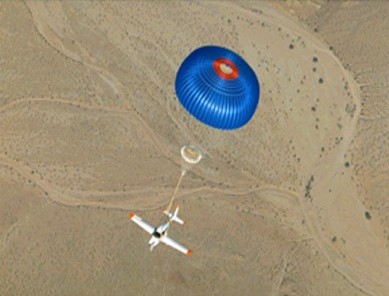
How many more will have to die before we insist on common sense safety devices?
In the 1920s there was a plane brought to earth by an accidental parachute mishap. In fact, here is the account of Aviation legend, Roscoe Turner describing why we need parachute recovery of airplanes and his test proving the concept:
Our study of aviation history is that it was easier to bail out with a parachute than to try to recover the entire plane (no modification to the plane), so people like Lindbergh during the 20/30s took the least costly approach. Its only of recent years where we have been in denial and non-chalance when we stopped wearing parachutes when flying. The problem of crashing has not gone away. Here are two tragedies:
Cessna 172 Engine-out Crash into Power Lines
Cessna 172 crash into Baseball Field
www.youtube.com/watch?v=1Pj8iFpJWsk&mode=related&search=
Ounce of Prevention
More proof that EVERY twin-engined and smaller plane should be equipped with a BALLISTIC RECOVERY PARACHUTE:
www.combatreform.org/parachute.htm (this web page)
Even at the low altitude shown here in this video (pilot knew he was in trouble at higher altitude) a BRP would have deployed and slowed down the impact preventing fire. Here's a YOUTUBE video of a BRP in action:
 www.youtube.com/watch?v=I84d0TD0E0E
www.youtube.com/watch?v=I84d0TD0E0E
Another point: all small aircraft need to switch to safer, less volatile DIESEL fuel engines ASAP...just like our ground motor vehicles (cars, trucks) etc.
Pound of Cure
Having established what should have taken place BEFORE the crash....taking what happened at face value;
1. Announcer should have ordered EVERYONE AWAY from the aircraft except a small number of rescuers and then told them if they want to HELP GO GET A FIRE EXTINGUISHER instead of gawking
2. He should have stopped broadcasting and called 911 with exact location for them to go to
3. If he had cell phone walked onto field and ordered everyone away and to get fire extinguishers---if he knew where one was he should have went to it immediately since his 911 call had done all he could do at that point to get better equipped help
4. Once with a fire extinguisher he could spray if necessary to get to people inside to rescue them or even put a small fire completely out. If he could reach inside TURN THE ENGINE IGNITION OFF.
Engines are usually hot so cooling down by extinguisher is good precaution to keep spilled fuel from igniting
5. Get everyone away from the plane except those with extinguishers watching to snuff out any flare-ups
6. Occupants in plane render first aid if required
Pilots use parachutes for spin recovery, why not TOTAL RECOVERY?: WHEN EJECTION SEATS DON'T WORK: RIGHT THE PLANE WITH A TAIL CHUTE
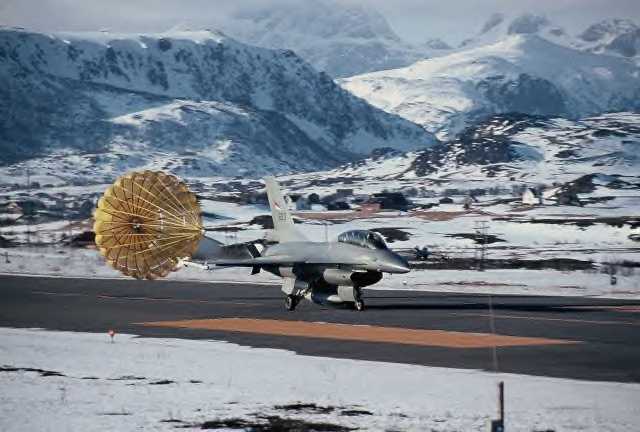
We just got done re-reading an old tragic report (see below) of two people dying in a T-2 Buckeye jet trainer spin where the IP didn't have his lap belt tight so in zero-G his head slammed against the cockpiit so unable to reach either top or bottom eject handles and the chick student pilot wasn't trained to turn a lever before pulling her ejection seat handles, by the time they punched out they were upside down and too low.
It occurs to us that had their jet had a brake parachute it could have at the very least yanked them out of the spin for a safe ejection. If we can't get a Recovery Parachute to bring the whole plane down, at the very least ALL jets should have brake/spin recovery chutes. After the crew ejects, the brake/spin chute should deploy to lessen the severity of the crash from 500+ mph pancaking into a row of houses to a vertical descent at 200 mph that people on the ground would have time to get away from.
A side benefit is shorter landings and help if the brakes fail.
By Matthew Brelis, Globe Staff, 11/09/97
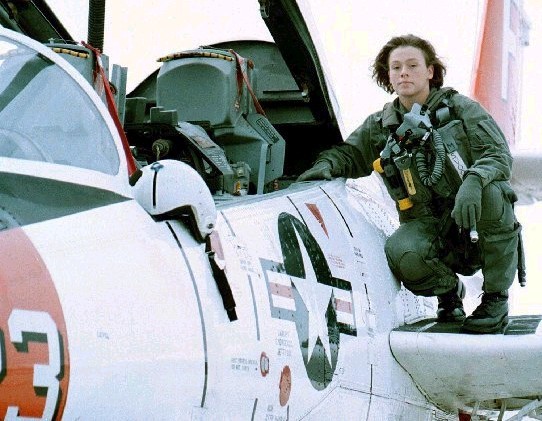
After spending 14 weeks trying to determine the cause of the crash of a T-2C Buckeye training jet that killed a Navy flight instructor and his [female] student aviator, U.S. marine Captain Paul E. Bowen came to a frightening conclusion: Many Navy and marine jet fighter flight instructors were unqualified for their jobs and in over their heads.
But the commanders who received Bowen's investigation of the 1992 crash that killed flight instructor Lieutenant Commander Gene D. Murrell, 46, and his student, Terri L. Wolthers, 28, quashed the report, the Globe has learned. The investigation was then ordered redone. [Cool! maybe the Cable-car massacre MC Colonel was there for that one!]
The new report, finished in less than three weeks, came to vastly different conclusions: There was no suggestion that Murrell or other jet instructors might be unqualified. And in approving the second report, officers up the chain of command blamed Wolthers for not ejecting from the aircraft sooner.
How the Navy handled the investigation into the obscure July 22, 1992, accident in a Mississippi forest is a startling example of the conflict of interest that is built into its method for probing fatal aviation accidents involving the Navy and marines. The commanders that ''own'' the plane that crashed also appoint the investigators. Because of that, they can control the direction and outcome of the investigation.
A Navy spokesman said the judge advocate general's office in Washington never received Bowen's report so it cannot comment on the conclusions he reached. Commander Brett B. Bernier, who conducted the second investigation, is no longer in the Navy and refused to comment. The squadron commanders who assigned the probe to Bernier have also left the Navy and could not be reached.
In a series of articles in June, the Globe reported that safety in the military is underfunded, investigations in the other service branches are compromised by the same conflict of interest that Bowen encountered, and that safety recommendations resulting from accidents in each of the services are frequently ignored. A computer-assisted analysis by the Globe of military records found that since late 1979, more than 2,100 service members died in aviation accidents that destroyed airplanes worth more than $20 billion.
After the articles, Defense Secretary William S. Cohen ordered the Defense Department inspector general to conduct a sweeping review of training and safety in the military.
The rewriting of his report to the judge advocate general has left Bowen, who retired from active duty in November 1992 after he submitted his report, and the Wolthers family believing the Navy covered up embarrassing truths and, in the process, kept other student aviators at risk.
"Terri chose a career fraught with risks, but I had always thought those risks would be minimized by those in charge," said the student pilot's mother, Mickey Wolthers, who has read Bowen's report.
"I had no reason to believe that the Navy would cover up the incident, but I don't feel that way anymore," she said. ''They left out important findings and attempted to blame the accident on Terri; that is not OK. They disregarded their own orders; that is not OK. They put an instructor in the plane not trained to Navy standards, and that is not OK."
Bowen was more blunt, saying, "I don't know how some officers can sleep at night."
Bowen's report concluded Murrell, the flight instructor, did not belong in a jet aircraft because he had not undergone the training Navy regulations require when pilots switch from propeller aircraft to jets.
As a result, Murrell, who felt uncomfortable doing the high performance flying required in jet training, tried to compensate by studying the instruction manual for the Buckeye. That strategy, Bowen found, left Murrell "perpetually `inexperienced' while an instructor pilot in the Intermediate Strike [jet fighter] Program."
Bowen wrote that putting pilots with helicopter or maritime experience in the fighter jet curriculum, ''is to match `inexperienced aviators' with `inexperienced student Naval aviators.' The operational environment is unforgiving when out of control flight or other emergency situations develop.''
Navy spokesman Lieutenant Patrick Moore said 57 percent of the current T-2 Buckeye instructor pilots did not come up through the ranks as jet fighter pilots. However, he said, under Navy regulations, they receive 41 weeks of jet training before becoming instructors.
Murrell had only 11 weeks of training.
Bowen's report stated that the practice of having non-jet pilots be jet instructors should be stopped. The second investigation made no such recommendation.
''I found out in January of 1993 that they were re-doing the report,'' Bowen said. ''I got a copy of Bernier's report in July. When I read it, I should not have been surprised, but I was outraged. When the Navy chief of training faulted the student, I found that to be extravagant. That is like me saying the mishap was due to Murrell's misconduct. It just shows how completely insensitive Navy leadership is to this.''
Had the Navy handled Bowen's report normally, it would have been sent up the chain of command for approval and criticism. Superior officers would have been required to respond to Bowen's charges and say why they had allowed someone who was not fully prepared to become a jet pilot. The report might have caused the Navy to delve into the underlying causes of the crash, making systemic changes where needed and disciplining the commanders who were responsible.
Trained on cargo flights
Murrell was a skilled, careful pilot who came up through the propeller-driven maritime ranks. At the time of his death, he had accumulated more than 4,200 hours of Navy flight time since he began flying in 1968. During his career, largely spent delivering cargo, Murrell had a distinguished record of more than 400 carrier landings. He never had had an accident, nor was he cited for a flight violation.
Bowen was unable to say in his report, or in a series of recent interviews at his home in Southern California, who was responsible for allowing Murrell to start flying jets without the training that is required under Navy regulations.
What is clear is that Murrell ''bypassed all the checks and balances in the system,'' Bowen said. There were two chances for Murrell to get experience in the T-2C and in both cases he did not. As a result, his commanders never learned of Murrell's aversion to high performance jet flight, and he was not trained to master the Buckeye's problem-ridden ejection system.
Had Murrell received the normal amount of jet instruction, he would have had about 90 hours in the T-2C Buckeye and 100 hours in another type of jet trainer. In an interview, Bowen said that such training would either have exposed Murrell's weaknesses or given him the experience learned from aviators who had spent their careers in jet fighters.
After getting 550 hours in a jet air transport from 1989 to 1991, Murrell went to the Naval Air Station in Beeville, Texas, in August 1991 with the assignment as a jet flight instructor. It was a disappointment to him, as he had been hoping he would be stationed at Pensacola, where his wife and two children lived, to fly cargo flights.
Lieutenant William Francisco flew instructor-under-training flights with Murrell at Beeville and had immediate reservations: Even flights with sudden dips and turns seemed to bother Murrell.
''I explained to him that the T-2C Buckeye syllabus involves some serious `yank and bank' and overhead flying [aerobatics],'' Francisco told investigators. On one flight, Francisco made the plane go nose down, which created the same negative gravity environment that made Murrell float out of his seat. ''Once on the ground I could tell he didn't enjoy the unusual attitudes I had given him, and he was a little upset,'' Francisco said.
''I have the feeling that the Navy put Murrell way over his head by sending him to be an instructor in Intermediate Strike. The flight we had together was good, but he did not want to be there.'' Francisco said.
When Beeville was closed, Murrell was transferred in April 1992 to Meridian Naval Air Station in Mississippi. He was closer to Pensacola, but he was still training jet fighter pilots. Many at Meridian knew of Murrell's dislike for aerobatic flying. In one briefing, Murrell told Lieutenant Patrick M. Timothy that he hated the flight they were about to take, known as FAM-12, or the 12th in a series of student familiarization flights.
''I thought that this was a `different' attitude for a `jet pilot,','' Timothy told investigators. ''On FAM-12, you are getting to do all the `good stuff.' FAM-12 is only one of a couple of flights where you get to go `upside-down.'''
Wing-over ended in dive
Wolthers had dreamed of flying jets since seeing the film, ''An Officer and a Gentleman,'' when she was 15. After graduating from college in 1990 with a degree in aeronautical engineering she was actively recruited by the Navy. She made it through Aviation Officer Candidate School where she said she had been sexually assaulted by her drill instructor, according to Bowen's report. She did not press charges, but others with the same drill inspector did. Wolthers was to testify at the court martial on July 27. Friends said she was concerned her integrity would be attacked, but was able to keep focused on her flying. On the morning of July 22, the two climbed into the two-seat twin engine jet. Wolthers sat in front; Murrell was in the rear.
The flight took off at 7:46 a.m. When they reached the practice area, they attempted a wing-over, which did not go well. It is not known who was flying. Bowen, however, said it is likely that Wolthers first tried the maneuver, and that Murrell then took the controls to demonstrate the proper technique.
Suddenly, something went very wrong.
Bowen believes that the elevator trim motor, which moves the tail section to control the plane's pitch, malfunctioned, forcing the plane to dive. When the nose dropped, the cockpit experienced negative gravity, raising Murrell out of his seat because his lap belt was not tight. In the preflight check list of the Buckeye, there was nothing directing pilots to check lap belts. They were only to make sure harnesses were secure. [Editor: retire the T-2C!]
Both Bowen's investigation and Bernier's agreed that because of his loose belt, Murrell was floating up against the canopy, unable to reach either the upper or lower ejection handles.
Over the next 30 seconds, the plane's rate of descent increased, according to radar. At 8:17 Murrell radioed: ''Mayday, mayday, mayday.'' His distress call came nearly half a minute after the plane began its rapid descent, falling from 4,500 feet per minute to 9,000 feet per minute.
Had he initiated ejection, the plane would have automatically sent a radio distress call.
"Murrell has already lost control of an aircraft and the situation,'' Bowen wrote in his report of this moment. ''Under duress, he has already started to `waste' valuable time by making a completely unnecessary distress call. This can only be regarded as a reversion to emergency procedures which are more familiar to him, which are transport aircraft in distress procedures. Trouble is, he is not in a transport aircraft."
The plane was upside-down, now plummeting in a spiral at 11,000 feet per minute, with its nose at a 50 degree angle. The plane passed through 7,000 feet, the minimum safe ejection altitude for out-of-control flights, but Murrell was still unable to pull either ejection handle. So he called out, ''Eject, eject'' 19 seconds after his distress call.
Wolthers responded: "See ya, Sir."
In her training, including simulator flights, Wolthers had been able to eject from the plane. But this time, when she tried to eject nothing happened: A control mechanism made Murrell's cockpit the only one to initiate ejection. Both investigations found she had not been trained to first switch the control mechanism to her cockpit and then eject.
Murrell was finally able to pull the upper ejection handle, but it was much too late. Both fliers, upside-down, were rocketed towards the ground, parachutes unopened. They died instantly.
[Editor: ALL jets need at least braking parachutes in the tail for spin recovery if not large parachutes to RECOVER THE ENTIRE PLANE.]
Murrell had been a jet instructor for eight months. Wolthers had 20 hours of flight time in the T-2C.
Dan Wolthers, Terri's father, remembers his daughter as someone who wanted desperately to be a Navy jet fighter pilot. [Editor: the kind of existentialism for self-esteem we do not need in our military]
He recently recalled how she called him after flying solo in a propeller Navy training plane for the first time. ''I said, `Honey, were you scared?' and she said, `I didn't even think about it until I got up there and leveled off and thought: Wow! The Navy trusts me with this $2 million airplane.'
"I guess maybe she should not have trusted the Navy."
Stephen Kurkjian of the Globe Staff contributed to this report.
Stephen Chalupa proposes passenger escape pods like the F-111 fighter-bomber uses--but on a larger scale:

If it saves just one life, it will be worth it.

Now let's strip away the conventions. Most pilots are totally focused on Pilot, Engine and Airframe (PEA) as the solution to every aircraft problem. Almost every pilot I have talked to is PEA narrow in focus. The fixed-wing airplane requires forward motion to keep itself flying in the air. Many accidents occur during the take-off run and landing which require runways--perhaps the ENTIRE DESIGN of PEA is faulty--perhaps an Autogyro that can land/take-off anywhere, a much more forgiving aircraft than a fixed-wing or a helicopter is the ultimate answer. Put fixed wings on it so it can fly like a regular plane at high speeds (Gyro-Coptor), if something goes wrong, it has rotor blades to lower it to safety in a small opening, not slam into the ground or skid across the ground at 100-300 mph. So let's face it, PEA is going to fail.
The "P" in PEA fails 46% of the time in all aircraft crashes.
The "E" and the "A" fail 22% of the time in all aircraft crashes.
Details: Aircraft Crash Data Base
The other 20% is Weather and a surprising 10% is SABOTAGE.
Think about it.
At some point PEA is going to fail in themselves, or in the face of weather, mid-air collisions and sabotage. Yes, we should make airliners more crash-worthy and line their cargo holds with kevlar to survive bomb blasts (Airframes). We need another OPTION (other than crashing); one of those options is the parachute--a bail-out parachute for the passengers themselves or a larger parachute to bring the entire plane down. I don't know why or how something that would save your life is opposed, but its better to be ALIVE then dead. Don't let ego, non-chalance and narrowness make your choices for you. PEA + RP = more lives saved. Our biggest obstacle is the ego of pilots towards saving their own lives and the lives of their passengers. Next is the anti-intellectualism and blue-collar fatalism of the American people themselves who are ignorant of the laws of physics, aviation matters derived from living a sheltered life devoid of any life-threatening situations (would rather sit in their seat and crash/burn than get off their ass and jump/parachute and live) which would teach them that when you have a chance to exert control over a situation with a high possibility of survival take it, since it might not be better a few seconds later.
I'm sorry, the truth hurts. But better a bruised ego (Pilot's), bruised BS world-view (blue-collar fatalism) resulting in a saved life or lives than more tragedies.
We love how losers who want to sit on their ass and do nothing---- make excuses using "statistics" to make us believe the status quo is "ok". We love how they react to the "statistic" below showing how airline pilots have the most dangerous job in America second only to fishermen and loggers. Any takers?

WHAT CAN WE DO NOW?
1. Recovery parachutes on all light planes
2. Smoke hoods on all airliner seats
3. Line cargo holds of airliners with kevlar to deflect bombs
4. Start designing a crash-worthy Burnelli civil-military airliner Extreme Short Take-Off and Landing (ESTOL) aircraft
5. R&D for passenger escape pods Re: Stephen Chalupa's F-111 style concept
WHAT CAN WE DO IN 1-5 YEARS
6. Passenger exits modified for parachute bail-out
7. Develop passenger seatpack bail-out parachute/life preserver
8. Air bags
WHAT WE CAN DO IN 5-10 YEARS
9. Field Burnelli crash-resistant ETSOL airliners
10. Transfer old tube/wing airliners to U.S. military for cargo use
11. Perfect pod escape system for Burnelli airliners
RECENT HISTORY OF AVIATION NON-CHALANT SHAME
Remember Jessica Dubroff? 7 years old. DEAD. Her father, DEAD. Her flight instructor, DEAD. John Denver, DEAD.

All Could have been saved by a recovery parachute starting in 1996. How many more JFK Jrs, Jessicas, Bessetts, John Denvers will have to die in the 1200+ general aviation accidents in the U.S. before we install recovery parachutes on ALL light planes? Think of all the famous people who died in plane crashes... Maybe YOU will be next.
1. January 28, 1986

Seven crewmembers board the Challenger for what should have been a 6-day mission. As all of America watched, the Challenger takes off. Seventy-three seconds into the flight, an explosion. Telemetry (signals from the astronaut's body vital signs) report that all seven crewmembers were still alive as they plummeted 65,000 feet into the Atlantic Ocean. If you don't realize this, click on this link and hear them curse, pray and cry for over 2 minutes before they hit the water. Or scroll down to the bottom of this page. (It was so disgusting I had to include it). Whether this is THE transcript of their last words, the truth that they could have been saved, recovered and merely a shuttle written off would have been an immense victory had NASA had the humility to admit "murphy" can strike and have a Course Of Action (COA) available to meet the problem. But NASA like the rest of the aviation community is in a state of arrogo-denial.
The Gemini program space capsules had two ejection seats for both astronauts. The Russians had a crew of cosmonauts who were saved from a fiery death on the launch pad by a similar system. NASA has Recovery Parachutes to bring the space shuttle Solid Rocket Boosters (SRBs) back to earth.....but I guess these are more important than people...is it a wonder that NASA is so "gaga" over unmanned missions? (Abilty to spend BILLIONS without risk of killing someone and pissing the American people off). Yet the new Space Station doesn't spin to create artificial gravity, and has no micometeroid/space junk collision protection...hmmm...ever think they don't want us to ever get into space??
NASA Astronaut Admits Ejection Seats Could Have Saved the Challenger Shuttle Crew
www.aulis.com/shuttle.htm
Shuttle a Deathtrap, says Astronaut
by Robin McKie
Science Editor The Observer

One of America's most experienced astronauts has denounced the space shuttle as a deathtrap and accused U.S. space officials of stifling all concerns raised about its safety. The revelation comes as America prepares to commemorate the 20th anniversary of the Challenger disaster. Seven astronauts were killed on 28 January 1986, when their shuttle exploded 73 seconds after take-off.
Veteran astronaut Mike Mullane's outburst therefore comes at a deeply embarrassing time for the NASA. Apart from dealing with the Challenger anniversary, it is now struggling to save its remaining space shuttles so they can complete the international space station.
However, all three - Discovery, Atlantis and Endeavour - are still grounded because engineers have not yet fixed insulation problems that doomed Challenger's sister craft, Columbia, in 2003.

Clint Eastwood movie, Space Cowboys shows a Shuttle Bail-out during the Gliding Landing--which Cannot Save them During Boost or Re-Entry Phase
"It's the most dangerous manned spacecraft ever flown," said Mullane, who took part on three shuttle missions before retiring in 1990. "It has no powered-flight escape system... Basically the bail-out system we have on the shuttle is the same bail-out system a B-17 bomber pilot had in World War II."
It was this lack of ejector seats that ensured the deaths of Challenger's astronauts. Such a powered escape system could have blasted them from their stricken ship and saved them.
"That was the true tragedy of Challenger. Nothing was learnt. Only janitors and cafeteria workers at NASA were blameless in the deaths of the Challenger seven," said Mullane.
"Columbia was a repeat of Challenger, where people had a known design problem and launched anyway." Mullane added that astronauts deserved some share of responsibility for not pursuing safety issues more doggedly.
It is estimated that it now costs NASA $5bn a year to pay for the 16,000 engineers who maintain the fleet - even if none of them actually flies. As a result the bill for designing, building and launching the shuttle has now topped $150 billion.

Engineers point out that the craft has been responsible for putting the Hubble space telescope and the International Space Station (ISS) into orbit. However, each craft has thousands of critical components.
A failure of any of these will doom a craft. On Challenger, it was a seal on a solid rocket booster. On Columbia, it was piece of loose insulation foam.
"You walk in terrified of doing anything that might jeopardise your one chance to get to space," Mullane said in an interview to promote his new book, Riding Rockets. "It's not like other jobs, where if you get frustrated you can go in to your boss and say 'Shove it!' You can't do that at NASA because there's no other place to go fly shuttles."
The three remaining shuttles are supposed to retire in 2010 after completing construction work on the orbiting space station, which has been operating with a skeleton crew of two since the Columbia disaster.
Source: The Observer Jan 22, 2006
Here's an article showing that in 2001, NASA was about to kill another shuttle crew by their defeatist non-chalance:
Web posted Saturday, January 27, 2001
NASA considering crew escape systems
The Associated PressCAPE CANAVERAL, Fla. (AP) -- Fifteen years after Challenger disintegrated in the sky, NASA is considering a variety of escape systems -- ejection seats, flyaway capsules -- that could save the crew in another space shuttle accident.
It is the most extensive and expensive look at shuttle crew escape systems ever conducted by NASA. Engineers expect to wrap up the yearlong, $5 million study by spring. But ultimately, the space agency may decide not to add any such features.
NASA puts the odds of a catastrophic accident during launch -- the most dangerous part of any shuttle mission -- at 1-in-438. Shuttle flight No. 102 is coming up in a week and a half.
The leading contender among the safety features under consideration is the ejection seat -- the same system used for the Gemini program and the first four shuttle flights. The Mercury and Apollo spacecraft had rocket-powered towers to fling the capsules away in an emergency. None of these was ever used, but in the Soviet Union, an escape rocket safely pulled two cosmonauts from a burning booster in 1983.
Ejection seats were no longer considered necessary once NASA declared the space shuttle operational, beginning with flight No. 5 in 1982.
"It was the Titanic syndrome: 'Not even God can sink this ship,"' recalls former astronaut Bryan O'Connor, director of engineering at Futron Corp.
NASA's attitude changed with flight No. 25 -- the launch of Challenger, which took place 15 years ago this Sunday, on Jan. 28, 1986. All seven crew members were killed, including teacher Christa McAuliffe. The cause: a gas leak in the right booster rocket.
In the explosion, the crew module separated from the fireball and plunged into the sea. But the crew members had no parachutes and no way to jettison the hatch. They were wearing flimsy blue jumpsuits.
O'Connor headed a panel that looked at crew escape systems after the disaster. When shuttle flights resumed in 1988, he and other astronauts ended up with parachutes; partially pressurized, bright orange suits with emergency oxygen and survival gear; a hatch that blows open; and a pole for sliding out of the spacecraft. [Editor see the excellent film, "Space Cowboys with Clint Eastwood to see these in action]
The Challenger explosion happened 73 seconds after liftoff. The escape systems now under consideration could be used during the first three minutes of flight at an altitude of 150,000 feet or more, as well as during landing and even on the launch pad.
Any one of these systems might have saved the Challenger crew, says Kevin Templin, a project manager in the shuttle engineering office. Challenger's crew module separated intact and went into a 2 1/2-minute free fall from 50,000 feet. SEE TRANSCRIPT OF THE 7 CHALLENGER ASTRONAUT'S LAST WORDS BELOW AT THE BOTTOM OF THIS WEB PAGE. ITS TOO BAD IT WASN'T NASA BUREAUCRATS TUMBLING IN THE SHUTTLE FRAGMENT IN 1986; I'D LIKE TO HEAR THEM SAY SUCH THINGS LIKE "WE DON'T HAVE THE TIME AND MONEY TO INSTALL EJECTION SEATS" WHILE THEY ARE SECONDS FROM DEATH...
Military-style ejection seats probably would be the easiest system to implement. More extreme would be a crew cabin-turned-escape capsule that would be capable of parachuting onto either land or water.
There is also the extraction method, in which miniature rockets would pull astronauts from their seats. Although the lightest option, it could accommodate only five astronauts rather than the desired seven. The capsule could fit in everyone but would add 8,400 pounds to the shuttle and cut into payload weight. Ejection seats could accommodate six astronauts but would take up precious cabin space. [Editor, here come the defeatist, status quo, bullshit, loser mentalities]
"Yes, I would feel better if I had some sort of escape system, but to do so at this stage in the design would make it worse, it would make life so much worse," says Kenneth Cockrell, commander of the next shuttle flight. "The concepts that I've seen just take the crew compartment down to nothing." [Editor: TOO FUCKING BAD, IT BEATS DYING, YOU IDIOT]
Each method requires explosives for blasting out of the shuttle, which introduces the danger of something backfiring.
Then there is the cost. Elric McHenry, manager of space shuttle program development, estimates an ejection or extraction system would cost hundreds of millions of dollars. A crew module capable of separating from the shuttle could cost $1 billion or more.
[Editor: another Challenger disaster and you won't have a manned space program, you lazy bureacrat]
The conclusion may well be that none of these systems is cheap enough, light enough, practical enough and easy enough to implement.
[Editor: no that's the lowest common denominator, weak, loser thinking of a media person who does do accomplish tangible things (shit) in real life]
A major factor is the international space station. If NASA hopes to finish building it in five years, then space shuttles cannot be grounded for major overhauls.
[Editor: an explosion and loss of shuttle and crew will be even worse]
Another factor is the longevity of NASA's four space shuttles. It wouldn't make much sense, McHenry and others point out, to install expensive escape systems if the shuttles are not going to be around for long once the space station is built.
[Editor: whatever BS excuse the bureaucrat can conjure up to not solve a problem is preferable to meaningful, solving-the-problem actions]
Besides, NASA concedes even the most elaborate escape system cannot guarantee crew survival.
[Editor: FUCK NASA. With this loser's mentality why get out of bed every morning? You cannot guarantee you will not die someway. When you can do something to protect LIFE you do it, you do not make bullshit excuses, YOU DO IT]
In the end, the findings may be left for the designers of follow-on spaceships.
[Editor: there will not be any other follow-on spaceships if NASA murders another crew]
Retired NASA engineer Don Nelson says that would be unconscionable.
[Editor: notice he is retired and not involved in the bureaucracy anymore]
"They're taking a very big gamble -- when they don't need to," says Nelson, who has a book coming out titled "NASA ... You Have a Problem."
He proposes replacing shuttle pilots and flight displays with an automated launch and landing system, thereby saving enough weight to put a pop-out crew module in the payload bay.
Otherwise, he says, "you're going to have to live with this vehicle and lose another crew someday. And we will. The warning signs are all there."


The lazy, uninformed American mind can accept an ejection seat from a fighter at 0-600 mph at zero altitude but cannot seem to accept a parachute at 120 mph from thousands of feet on a light plane...Is it ignorance, non-chalance or nihilistic fatalism, or all three?
2. November 22, 1996

The eleven-man crew of King 56 is en route to their destination in the Pacific north west. One by one, their engines fail. Their HC-130 Hercules tanker plane becomes a glider, no engines, no power, no controls. Slowly, the plane descends. It will take 16 minutes before the plane crashes into the Pacific Ocean. The crew frantically tries to regain control. Finally, giving up hope--they decide to prepare to crash land in the water, making the fatal mistake of "going down" with the plane instead of parachuting out and floating safely to the water and insuring they are away from the crash/wreckage. Ten of the Eleven crew members die trapped inside the flooding aircraft.
3. July 19, 1989
DC-10-10, Flight # 232, Sioux City, Iowa experiences a failure of the number two tail mounted engine during the flight which knocked out the flight controls. The crew had severe difficulties controlling the plane using the engine thrust to steer it. They crash land--One hundred and eleven dead.
4. September 11, 1991
Twin-engine commuter flight, Continental Express plane, Eagle Lake, Texas. Forty-seven screw fasteners are removed during inspection, the inspection crew forgets to re-install these screw fasteners. The plane takes off and breaks up in the air. All fourteen members die.
5. August 21, 1995
Flight 529, Carrollton, GA, a fracture and separation of a propeller blade causes the plane to plummet from 18,000 feet. Eight people die
6. October 14, 1994
American Eagle, flight #3379, Greensboro, North Carolina, loses power in one engine, drops 1400 feet to a fiery crash. Fifteen people die.
Is it possible that some of these crew/passengers could have survived?
The answer is YES.
If only they had parachutes and used them. Why are military and civilians not being allowed/or not using parachutes to escape these plummeting death traps?
The reasons I come up with are frightening: ignorance, denial, non-chalance, arrogance, statistics as excuses, cowardliness, fatalism.
We need to accept the fact that some planes will crash. Sometimes, unfortunately, there are no warnings, no time to prepare, my colleagues and I are well aware of this fact. If giving the choice of possibly living or possibly dying -- I would rather go out trying. But as it exists today, we the American people (military and civilians) do not have this choice. We have very little chance of surviving if the plane we are on malfunctions. We are trapped in a huge structure hurtling to the ground. Someone else NOT on the airplane has made the choice for us.
Why not a parachute under the seat cushion of every passenger/crew member? The flight attendants can help passengers with their parachutes. As soon as an in-flight emergency is detected that would make a crash landing inevitable, passengers would be donning parachutes. Below 10,00 feet (so oxygen is not needed) the aircraft depressurizes and the doors would be opened. Planes that are filled with smoke from onboard fires cannot be flown by their crews since everyone suffocates as soon as their emergency oxygen runs out, and inevitably crash. This is because doors on civilian airliners in flight cannot be opened to vent out the smoke like military aircraft can. This should be changed so they can be opened without the crash landing slide/rafts deploying. Then, before the plane crashes, the passengers can start exiting the plane. As soon as you exit the plane, you pull the cord to deploy your parachute....that=s all there is to it.

These parachutes can be made one-size-fits-all on each sitting position on the plane for the disabled, parent traveling with a young child, and for the larger-size passenger. Each parachute would have a built-in flotation device and a quick-pull release to detach the parachute when the passenger safely lands.
Americans need to demand this life-saving precaution. Shouldn=t we expect to be given every opportunity to survive? Stand-up American--fight for our life, your friends life, your neighbors life, your fellow Americans' life. Lets not wait until the next disaster.....as sure enough their will be one, before we speak out. Lets prevent more unnecessary, needless, senseless, BUT preventable deaths.
Contact the Federal Aviation Administration (F.A.A.) and demand that you and others be given this chance to survive.
Sincerely,
Carol Murphy
NOTES

1. www.flyingmag.com/article.asp?section_id=13&article_id=510
Chute: What the whole-airplane recovery parachute system is doing for safety
By Robert Goyer
December 2004
It's standard equipment in nearly 2,000 Cirrus airplanes. What's it doing for pilot safety, and will it mean to you?
Last April, an instrument-rated private pilot took off from Fort Lauderdale Executive Airport in his SR22 bound for Palm Beach International. It was solid IFR, 400 overcast. The pilot was experienced in Cirrus airplanes-he was a founder of the Cirrus Owners and Pilots Association-he regularly flew such IFR flights, and he knew his airplane well. As he rotated and began to climb, all systems looked good.
Then, just after he had entered the soup at right around the advertised 400 feet things started to go wrong. The altimeter began to fluctuate wildly, and the pilot called ATC to report the problem and to request a return to the airport. He got a vector, but things soon got worse, and he came to believe that the attitude indicator and turn coordinator were indicating differently. As he desperately tried to sort things out, he realized that he had no idea how high or where exactly he was.
In years past, the NTSB's report on this event very likely would have read something like this: "Witnesses reported seeing the airplane emerge from the clouds in a high-speed dive (or a spin; take your pick). The airplane impacted near vertically and the private pilot/sole occupant was fatally injured."
But that's not how this report read. Instead of struggling to regain his bearings at low altitude in the clouds, the pilot notified ATC that he was deploying the whole-airplane parachute system in the Cirrus. He killed the engine, pulled the big red handle overhead, and within a couple of seconds, the airplane began to descend under a 55-foot orange-and-white canopy. After what he remarked was a strangely quiet descent-despite the pilot's side door coming off when the chute deployed-the airplane came to rest in a tree. The pilot, who said that he didn't even feel the "landing," was unhurt.
In its preliminary report on the event, the National Transportation Safety Board pointed out that the pilot never switched to the alternate static source, and when inspectors looked at the airplane, they found water in the static lines. Might the pilot have been able to continue the flight and land without incident had he activated the alternate static? Maybe, but in the past a lot of other pilots in similar circumstances have proven not to be up to the task and paid the ultimate price for it. Unlike them, the Fort Lauderdale pilot is happily flying again.
I've been flying an SR22 for about 18 months now and, like a couple of thousand other Cirrus pilots out there, I've never had to do what that pilot felt as though he had to do that day. But it hasn't stopped me, or anybody else who climbs into one of these new airplanes, from asking the big question: Am I safer in this airplane than I am in others?
A chute is born: A near-death inspiration
The idea of a parachute that in case of dire emergency would lower the whole airplane, occupants and all, safely to the ground isn't a new one. Back in the 1940s, Flying featured stories and illustrations of several similar concepts, including ones for airliners and others where the wings were shed at deployment. None came to pass.
Then, in 1975 Boris Popov came up with an idea as he was falling 400 feet to what would surely be his death after his ultralight came apart in mid-flight. Popov didn't think he'd live to work on the idea-a rocket-enabled parachute that would rescue not just the pilot but the entire airplane-but, improbably, he survived the fall. Within a few years he had developed a simple, light rocket-propelled parachute system that would go into thousands of ultralight and light experimental airplanes.
By the 1990s parachutes manufactured by the company Popov had founded, Ballistic Recovery Systems (BRS), had proven their value in very light and ultralight airplanes with more than 150 documented lives saved.
But general aviation types didn't pay much attention, not even when, in the 1990s, BRS got a system certified for retrofit into Cessna 150s. It wasn't until Cirrus Design, a new company looking to certify a composite four-seater, announced that it would put a chute in the airplane, that people started paying much attention.
Cirrus co-founder Alan Klapmeier, who years earlier had survived a midair collision, knew from firsthand experience that there were certain circumstances under which there was nothing further the pilot could do. The chute, Klapmeier claimed, would allow pilots that last ditch chance to save the lives of the airplane's occupants, and Cirrus committed to it from the get-go. Today there are around 1,500 BRS systems flying in Cirrus SR20 and SR22 single-engine airplanes and many more in ultralight and experimental light airplanes.
Even before the SR20 was certified, it became apparent that a parachute in a certified airplane would polarize pilots, and it has. While anti-chute pilots take issue on several grounds, the most common complaint remains that the system takes control away from the pilot. And there's no denying that once the red handle is pulled, everybody onboard is along for the ride. Some pilots feel as though, and they put it in these words, "real pilots don't need chutes."
Another argument is that pilots will be pulling the chute willy-nilly. It's rare, but there have been cases of pilots making questionable deployments in light experimental airplanes equipped with chutes. These pulls took place in perfectly flyable airplanes when the pilot panicked, in a couple of instances because of extremely gusty conditions, fearing that he might lose control of the airplane. BRS has long argued that because pilots do sometimes die because they panic, the use of the chute in those situations, while not ideal, was appropriate.
A more reasonable argument than the "real pilot" one is that the CAPS could tempt pilots to fly into situations they'd normally avoid without the chute. Interestingly enough, Klapmeier's view is that there's nothing necessarily wrong with this choice.
That view is echoed by many Cirrus pilots, who admit that the presence of the chute influences their aeronautical decision-making, but only as much, most say, as it's a part of the larger risk assessment picture. I would never, for instance, continue VFR into IMC just because the chute was there, but I am more likely to make certain types of flights that I would not without the chute.
To pull or not to pull
While there are certain obvious pull-the-handle scenarios-such as those pointed out by Cirrus in the SR22's POH: structural failure, loss-of-control at low altitude, etc.-there are many other scenarios under which the call is more difficult. When faced with a forced landing with marginal sites available and imposing terrain elsewhere, would I call on the chute? I don't know. Would I choose to hit the silk in a high-speed dive after loss-of-control? After getting the airplane slowed down as much as possible, I probably would, even though CAPS has only been tested to 133 knots. What about after an engine failure shortly after liftoff with not enough runway and inhospitable terrain ahead? Again, I probably would, but it's impossible to say ahead of time. It comes down to pilot judgment in the end.
In its manual, Cirrus provides scant guidance. In the Emergency Procedures section, the SR22 POH says, "The Cirrus Airframe Parachute System (CAPS) should be activated in the event of a life threatening emergency where CAPS deployment is determined to be safer than continued flight and landing." (That's not much help; you could say the same thing about offering up a quick prayer.) The manufacturer goes into a little detail on the subject of when to pull the chute, explaining the possible scenarios: mid-air collision, structural failure, certain loss-of-control scenarios, a forced landing in inhospitable terrain and pilot incapacitation. At the end of the discussion of each of these scenarios, the conclusion is a directive only that "CAPS deployment should be considered."
On the Cirrus Owners and Pilots Association (COPA) website there is a surprisingly narrow range of opinion on the subject of the value and desirability of the chute. Everybody seems to like it, buttressing Klapmeier's claim that while some pilots come to the Cirrus unconvinced about the chute, nearly every one of them comes around. Is this just the rationalization of owners who have no choice but to accept the technology, since you can't get a Cirrus without the chute? It could be, but the fact remains, for whatever reasons, Cirrus owners are big fans of the chute, and their spouses are even more enthusiastic about it.
The subject of whole-airplane recovery parachutes is still mostly a Cirrus issue, but there's no telling how long that will last, and it hasn't kept pilots of non-chute-equipped airplanes from weighing in on the subject. In a non-scientific poll on our website (www.flyingmag.com), a large majority of respondents said that they'd put a whole-airplane parachute system in their airplane if they had the option.
Will it Work?
One early question was, would the parachute function as advertised? The issue seems to have been answered in the affirmative. To date there have been four "saves" directly attributable to the chute, resulting very probably in saving the lives of eight people, all of whom walked away from the airplane unscathed.
In the first incident, which took place in October of 2002, a private pilot in Texas was faced with the difficult decision of whether to pull the chute or not after his SR22 experienced control difficulties shortly after takeoff. The pilot quickly identified the cause: the left aileron was attached by a single hinge and was blowing in the slipstream behind the wing. After cutting the engine, he made the pull, and the airplane came down safely into an area of mesquite trees. The pilot was unhurt.
The next two pulls (of which one was the Fort Lauderdale event discussed previously) occurred last spring within days of each other. In the first, a private pilot made the pull after his SR20 encountered a hard-to-explain loss of control over mountains at night in British Columbia. The airplane came down on a steep gravel slope, and the four occupants walked away without a scratch.
A fourth pilot, a CFI, made another deployment recently when his SR22 went out of control at 16,000 feet over central California. The airplane landed in a tree, and the pilot and his passenger, his wife, were unhurt.
The Texas deployment involved a maintenance error that led to the failure of a control surface; two others, the British Columbia and California deployments, involved the loss of control of the airplane at altitude; and the Fort Lauderdale pull came after an apparent instrument failure. The chute in each case quickly put the airplane back under control (though not under the pilot's control). If you grant that these events are accidents-the NTSB is trying to resolve this question-then each of the four deployments are clearly loss-of-control-related, which is an all-too common cause of fatal light airplane crashes. Would each of the flights, in which no one was injured, let alone killed, have turned into a fatal accident had the pilot not deployed or not have had the option to deploy the chute?
It's hard to say. One might argue that with flawless pilot performance all three might have ended with an uneventful landing at an airport. But such a claim belies the accident statistics. A majority of fatal crashes are associated with poor pilot decision-making and/or technique. So, instead of asking the question, could the pilot have conceivably recovered the airplane from any or all of these events, it's more germane to ask, might any or all of them have resulted in fatal crashes? The answer to the latter question is "yes," or at least "probably."
So it's four-for-four for Cirrus with the chute, though there has been some luck involved. Most notably, all four airplanes came down in good landing sites-the Texas pilot was the only one of the four to specifically choose his site. While there have been a number of other Cirrus accidents, in none of them is it likely that the pilot (or other occupant) ever tried to deploy the chute, and there are indications that in a number of those accidents, including one that involved a VFR pilot flying his SR20 into low IMC, it might have saved the day.
One fatal crash took place after an SR22 entered a flat spin at approximately 5,000 feet agl. In this accident, currently in litigation, the role of the parachute is in dispute, and Cirrus believes that the attorneys representing the estate of the deceased pilots will argue that one or both of them tried in vain to deploy the chute. In its report, the NTSB simply said that they did not deploy the chute, and cited as a probable cause the failure to do so. Both Cirrus and BRS agree with the Board's report, and they contend that they can positively determine whether an occupant has tried to deploy the chute, even when there has been a post-crash fire, as there was in this crash.
It's also important to point out that the CAPS has only been tested to VA, which is 133 knots in the SR22. Consequently, an all-too-common accident scenario, loss of control leading to a spiral dive, might not be recoverable with the chute.
Altitude is another issue. In the POH, Cirrus points out that the airplane will lose a minimum of 920 feet of altitude following deployment at the entry to the spin. In straight-and-level flight, the POH says that altitude loss of less than 400 feet has been demonstrated. The Fort Lauderdale recovery reportedly was made at around 800 feet agl, and photographic evidence suggests that the airplane was recovered with altitude to spare.
Equipping the Fleet?
How might universal parachute equipage, if that were possible, change the safety picture? As a starting point, we might look at the track record of Cirrus SR20s and SR22s. While there have been four saves, there have also been eight fatal accidents, half of which, it appears, could not have been prevented with the use of the parachute. But based on the NTSB reports, half of those fatal accidents might have been saved with a timely pull that the pilot never made. That makes four actual saves out of a possible eight.
Because the Cirrus numbers are small, I looked at how the larger fleet might fare if every production single were equipped with a chute. I studied five months' worth of NTSB accident reports-76 in all-on fatal crashes involving single-engine airplanes.
I excluded twins, turboprop-powered airplanes and helicopters from the mix because, as it now stands, no chute option is available to any aircraft in their respective classes. I also excluded Experimentals of all types, because they are outside the target of the study: type-certified singles.
After gathering the reports, I read through them and made a determination as to whether the pilot might have been able to make a successful deployment or not. I also added a third category, for accidents about which not enough was known to reach a determination or, in a few cases, in which it was impossible for me to conclude with the information available whether the pilot could have pulled the handle in time.
In 45 percent of the accidents I studied, it was very unlikely that the pilot would have been able to make a successful pull. (For another 13 percent, there simply wasn't enough information available to make a determination.)
The majority of those accidents that I classified as "unrecoverable" involved unsuccessful takeoff or landing attempts. Examples included several attempted go-arounds that went awry close to the ground. Several involved takeoffs in high density-altitude conditions during which the airplane never climbed very high before impacting with terrain. The common denominator is that in neither scenario would the pilot likely have had enough altitude for a successful deployment.
Neither was the chute a probable remedy for several other kinds of accidents. These included five suicides, an unusually high number. Also, I classified as "unrecoverable" botched IFR approaches during which the pilot flew the airplane into the ground, usually in weather conditions at or below minimums. Likewise, other controlled flight into terrain accidents clearly would not have benefited from the presence of a chute. These included a few night flights that ended with the pilot flying the airplane under control in cruise or descent into the side of a mountain.
However, for 42 percent of the accident flights I surveyed, the parachute very possibly could have prevented tragedy. Many of these flights involved a loss of engine power at a recoverable altitude, often shortly after takeoff but at a height of several hundred feet or higher. Also, there were several harrying accounts of the last desperate minutes of communications between ATC and VFR-only pilots who had flown their airplanes into IMC. The outcome was predictably tragic. Fuel exhaustion was another common scenario, as was inadvertent flight into too-rapidly rising terrain and a couple of midair collisions. All of these fatal accidents might have turned out differently had the airplanes involved been chute equipped.
But by far the most common fatal accident cause in the sample was the pilot losing control of the airplane. I classified some of these accidents as "unrecoverable" because the airplane was too close to the ground, in my estimation, to give the pilot enough time to make a successful pull. But many loss-of-control accidents involved pilots losing control at pattern altitude or higher with the airplane subsequently spinning in, again, with fatal results. A timely pull on a handle might have prevented many of these fatalities.
With a chute in every airplane, how many lives might be saved in a typical year when there are around 300 fatalities in type-certified single-engine airplanes?
In my five-month study, the death toll in the potentially recoverable category was 59 people. (It was much higher with Experimentals in the mix.) A total of 72 people perished in crashes that I deemed unrecoverable or about which I couldn't make a determination. I then subtracted a percentage on the assumption that my "recoverability" determinations were optimistic, that a percentage of "saves" would go awry and that people would perish despite the deployment of the chute. On top of that, I factored in a small number of deployments that might result in fatalities instead of preventing them. Working in these factors, I came up with an intermediate figure of 50 lives saved in the five-month period, which comes to 120 lives saved when extended to cover a year's time.
Finally, since pilot error led to many of the accidents outlined above, it's only fair to assume that a number of pilots, perhaps as many as half, would fail to deploy the chute in a timely manner. So, factoring in pilot error in deploying the chute, a final estimate for lives saved per year (were the entire fleet equipped) is around 60, which represents 20 percent of all fatalities in certified single-engine airplanes.
While intriguing, I admit that the exercise is speculative. Retrofit whole-airplane parachute systems are available for just three airplanes, the Cessnas 150/152, 172 and 182, and only a handful of those airplanes are chute equipped.
The Future of the Chute
So far, only one new-airplane maker, Cirrus, has committed to the chute. Other major manufacturers have admitted only to considering the technology, and there are no signs that any of them will adopt chutes any time soon. Mark Thomas, president of BRS, says that there are economic factors working against the chute. For starters, it is expensive to engineer and certify a whole-airplane parachute recovery system. Also, the airplanes in which they're installed gain weight. (The chute in the Cirrus weighs around 65 pounds, including all of the system components, and more weight, 15 pounds or more, is lost in adding reinforcements to the airframe where the harness attaches to it.) There are also added, recurring costs. Rockets have to be replaced periodically-10 years for the Cirrus-and other system components need occasional inspection and/or replacement.
But even without other major airplane makers adopting the technology, chutes will become more common, thanks to the recent adoption of the Light Sport Aircraft rule, under which potentially dozens of new small airplanes will earn certification, many of them with whole-airplane parachute recovery systems as standard or optional equipment.
For now the real question is, how many lives will be saved by the whole-airplane parachute systems that are already on Cirrus, and a few other airplanes? In 10 years' time, assuming that Cirrus continues to build a thousand airplanes a year or more, it will likely be around a dozen or more people subtracted from the fatality column every year, which, even the skeptics would have to agree, would be a substantial improvement in safety.
Somewhat surprisingly, the market response to the products has been cool, though BRS says that the problem is at least in part a marketing issue. The company has been more involved in research and development than it has been in selling the product. So retrofit sales might pick up. The costs are reasonable enough. Thomas says that the system can be installed in one of the Cessnas for around $20,000, a figure dwarfed by the amount many owners spend on avionics upgrades. One hopeful indicator for BRS is that after 20 years in the market their chutes are a virtual staple in small experimental and ultralight airplanes.
It's hard to say how much of Cirrus sales success is a result of the chute and how much is in spite of it. Either way, today there is a growing number of production airplanes flying with whole-airplane recovery chutes as standard, factory-installed equipment. Klapmeier says that more pilots are coming to Cirrus expressly because it has the chute.
The ranks might some day grow to include pilots of larger and faster airplanes. NASA recently awarded BRS a Small Business Innovation Research grant to study the possibility of installing whole-airplane parachute recovery systems in airplanes weighing as much as 5,000 pounds and traveling at up to 350 knots.
2. The Challenger Transcript
A secret NASA tape reveals that the crew of the shuttle Challenger not only survived the explosion that ripped the vessel apart; they screamed, cried, cursed and prayed for three hellish minutes before they slammed into the Atlantic and perished on January 28, 1986.
The tape is said to begin with a startled crewman screaming,"What happened? What happened? Oh God - No!" Screams and curses are heard- several crewmen begin to weep- and then others bid their families farewell.
Two minutes forty-five seconds later the tape ends. That's when the shuttles crew compartment, which remained intact after the vessel exploded over the Atlantic, hit the ocean at over 2,000 miles per hour, instantly killing the crew.
" Cover up? Of course there was a coverup, " declared Robert Hotz, a member of the Presidential commission that investigated the disaster. " NASA can't face the fact that they put these astronauts in a situation where they didn't have adequate equipment to survive. NASA doesn't give a damn about anything but covering it's ass, " he said.
The official account released by NASA ends with shuttle pilot Michael Smith saying, " Uh-oh!" Some NASA employees have evidently heard more-much more. And they provided the rest of the account based on what they've discussed within NASA in the last five years. The astronauts had time and realized something was happening after the shuttle broke up.
" All shuttle astronauts carry personal recorders and the tape in question apparently came from Christa's (McAuliffe), which was recovered after the shuttle disaster, " said Hotz. Jarvis was sitting beside her, and when he figured out what was happening he said, " Give me your hand. "
" NASA insists there's nothing like that on tape but they're talking about the mission tape, not Christa's. So they're not lying, but they're not telling the truth, either. "
A journalist with close ties to NASA was even more emphatic, " There are persistent rumors, dating back to the disaster, that this tape is absolutely bone-chilling. "
The "official" version: (can you spell bullshit?)
National Aeronautics and Space Administration
Washington, D C. 20546
NASA has completed its analysis of the Challenger operational recorder voice tape. The enclosed transcript reveals the comments of Commander Francis R.Scobee, Pilot Michael J. Smith, Mission Specialist 1 Ellison S. Onizuka, and Mission Specialist 2 Judith A. Resnik for the period of T-2:05 prior to launch through approximately T+73 seconds when loss of all data occurred. The operational recorder is automatically activated at T-2:05 and normally runs throughout the mission. During the period of the prelaunch and the launch phase covered by the voice tape, Mission Specialist 3 Ronald E. McNair, Payload Specialist 1 S. Christa McAuliffe, and Payload Specialist 2 Gregory B. Jarvis were seated in the middeck and could monitor all voice activity but did not make any voice reports or comments.
TRANSCRIPT OF THE CHALLENGER CREW COMMENTS FROM THE OPERATIONAL RECORDER
CDR.....Scobee
PLT.....Smith
MS 1....Onizuka
MS 2....Resnik
The references to "NASA" indicate explanatory references NASA provided to the Presidential Commission.)
Time Crew Crew
(Min:Sec).........Position Comment
T-2:05............MS 2 Would you give that back to me?
T-2:03............MS 2 Security blanket.
T-2:02............MS 2 Hmm.
T-1:58............CDR Two minutes downstairs; you gotta watch running down there? (NASA: Two minutes till launch.)
T-1:47............PLT OK there goes the lox arm.
(NASA: Liquid oxygen supply arm to ET.) T-1:46............CDR Goes the beanie cap. (NASA: Liquid oxygen vent cap.)
T-1:44............MS 1 Doesn't it go the other way?
T-1:42 Laughter.
T-1:39............MS 1 Now I see it; I see it.
T-1:39............PLT God I hope not Ellison.
T-1:38............MS 1 I couldn't see it moving; it was behind the center screen. (NASA: Obstructed view of liquid oxygen supply arm.)
T-1:33............MS 2 Got your harnesses locked? (NASA: Seat restraints.)
T-1:29............PLT What for?
T-1:28............CDR I won't lock mine; I might have to reach something.
T-1:24............PLT Ooh kaaaay.
T-1:04............MS 1 Dick's thinking of somebody there.
T-1:03............CDR Unhuh.
T-59...............CDR One minute downstairs. (NASA: One minute till launch.)
T-52...............MS 2 Cabin Pressure is probably going to give us an alarm. (NASA: Caution and warning alarm. Routine occurrence during prelaunch).
T-50...............CDR OK.
T-47...............CDR OK there.
T-43...............PLT Alarm looks good. (NASA: Cabin pressure is acceptable.)
T-42...............CDR OK.
T-40...............PLT Ullage pressures are up. (NASA: External tank ullage pressure.) T-34...............PLT Right engine helium tank is just a little bit low. (NASA: SSME supply helium pressure.)
T-32...............CDR It was yesterday, too.
T-31...............PLT OK.
T-30..............CDR Thirty seconds down there. (NASA: 30 seconds till launch.)
T-25..............PLT Remember the red button when you make a roll call. (NASA: Precautionary reminder for communications configuration.)
T-23.............CDR I won't do that; thanks a lot.
T-15.............CDR Fifteen. (NASA: 15 seconds till launch.)
T-6...............CDR There they go guys. (NASA: SSME Ignition.)
MS 2 All right.
CDR Three at a hundred. (NASA: SSME thrust level at 100% for all 3 engines.)
T+O.............MS 2 Aaall riiight.
T+1..............PLT Here we go. (NASA: Vehicle motion.)
T+7..............CDR Houston, Challenger roll program. (NASA: Initiation of vehicle roll program.)
T+11............PLT Go you Mother.
T+14............MS LVLH. (NASA: Reminder for cockpit switch configuration change. Local vertical/local horizontal).
T+15............MS 2 (Expletive) hot.
T+16............CDR Ooohh-kaaay.
T+19............PLT Looks like we've got a lotta wind here today.
T+20............CDR Yeah.
T+22............CDR It's a little hard to see out my window here.
T+28............PLT There's ten thousand feet and Mach point five. (NASA: Altitude and velocity report.)
T+30 Garble.
T+35............CDR Point nine. (NASA: Velocity report, 0.9 Mach).
T+40............PLT There's Mach one. (NASA: Velocity report, 1.0 Mach).
T+41............CDR Going through nineteen thousand. (NASA: Altitude report, 19,000 ft.)
T+43............CDR OK we're throttling down. (NASA: Normal SSME thrust reduction during maximum dynamic pressure region.
T+57............CDR Throttling up. (NASA: Throttle up to 104% after maximum dynamic pressure.
T+58............PLT Throttle up.
T+59............CDR Roger.
T+60............PLT Feel that mother go.
T+60 Woooohoooo.
T+1:02.........PLT Thirty-five thousand going through one point five (NASA: Altitude and velocity report, 35,000 ft., 1.5 Mach).
T+1:05.........CDR Reading four eighty six on mine. (NASA: Routine airspeed indicator check.)
T+1:07.........PLT Yep, that's what I've got, too.
T+1:10.........CDR Roger, go at throttle up. (NASA: SSME at 104 percent.
T+1:13.........PLT Uhoh.
T+1:13 LOSS OF ALL DATA.
The following begins two seconds after NASA's official version ends, with pilot Michael Smith saying, " Uh-oh! " Times from the moment of takeoff are shown in minutes and seconds and are approximate. The sex of the speaker is indicated by M or F.
T+1:15 (M) What happened? What happened? Oh God, no - no!
T+1:17 (F) Oh dear God.
T+1:18 (M) Turn on your air pack! Turn on your air...
T+1:20 (M) Can't breathe... choking...
T+1:21 (M) Lift up your visor!
T+1:22 (M/F) (Screams.) It's hot. (Sobs.) I can't. Don't tell me... God! Do it...now...
T+1:24 (M) I told them... I told them... Dammit! Resnik don't...
T+1:27 (M) Take it easy! Move (unintelligible)...
T+1:28 (F) Don't let me die like this. Not now. Not here...
T+1:31 (M) Your arm... no... I (extended garble, static)
T+1:36 (F) I'm... passing... out...
T+1:37 (M) We're not dead yet.
T+1:40 (M) If you ever wanted (unintelligible) me a miracle... (unintelligible)... (screams)
T+1:41 (M) She's... she's... (garble) ... damn!
T+1:50 (M) Can't breathe...
T+1:51 (M/F) (screams) Jesus Christ! No!
T+1:54 (M) She's out.
T+1:55 (M) Lucky... (unintelligible).
T+1:56 (M) God. The water... we're dead! (screams)
T+2:00 (F) Goodbye (sobs)... I love you, I love you...
T+2:03 (M) Loosen up... loosen up...
T+2:07 (M) It'll just be like a ditch landing...
T+2:09 (M) That's right, think positive.
T+2:11 (M) Ditch procedure...
T+2:14 (M) No way!
T+2:17 (M) Give me your hand...
T+2:19 (M) You awake in there? I... I...
T+2:29 (M) Our Father... (unintelligible)...
T+2:42 (M) ...hallowed be Thy name... (unintelligible).
T+2:57 (M) You...over there?
T+2:58 (M) The Lord is my shepherd, I shall...not want. He maketh me to lie down in green pastures... though I walk through the valley of the shadow of death, I will fear no evil... I will dwell in the house...
T+3:15 to end. None. Static, silence.
FEEDBACK!
Mike Sparks writes:
"The part in the Flying magazine article that states "real pilots don't need chutes" made me want to vomit.
These motherfu*ker imbeciles should be denied pilot's licenses flying fuel laden planes over our heads. Why should we tolerate these narcissistic egomaniacs putting people on the ground at risk because they lack the adult humility to take RESPONSIBILITY for what they are doing? Responsibility means doing EVERYTHING you can to not kill themselves and people on the ground ie; using Recovery Parachutes."
Mike
Legendary combat tank sergeant Ralph Zumbro writes:
"Gents.
Ref; instrumentation, etc.
Some of this may bear on subject. All through WWII one of my senior cousins, one each Howard Addams (note spelling...one of the Addams familiy...NOT kidding) was a USAAF fighter pilot. 3 kills in a P-40. In 1948, as an 11 year old kid, I took a ride with him, along with my mother, who, widowed in 1940, was interested in the man. Remember mother watching the preflights in the KISS Piper, which he owned, asking when the ground checks would stop. Answer....'Never, until I get a message from GOD.' Remember a simple lead shot on a silk string which he took out of a pocket and hung on a hook over his head....Asked what that was for. Answer. 'the pitot tube can be stopped by a bug, altimeter can be blocked by a spider, electric instruments aren't trustworthy. All else fails, cut engine pull stick to belly and this will tell you where down is.'
Remember cousin Howard telling me that Ground Crew is at least as important as the pilot. 'The guy who sends you UP in that crate has to be a good friend and a drinking buddy.' He also said 'If crewchief hasn't personally guaranteed me that the plane will fight, all I do up there is fly and survive, not try for a fight.'.....Man learned to fly in 1930s at MacChesny airport in Rockford Ill (Now a shopping Mall)
Howard Addams died in 1951 in Alaska as a bush pilot who landed his single engine float plane, deadstick after an engine flight failure. Plane hit a submerged snag and sank. Howard had a cold immersion heart failure after shoving both his passengers out. Would an onboard chute have saved him.....Absolutely."
Ralph Zumbro